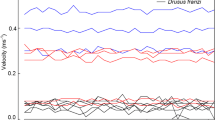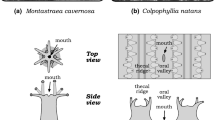Abstract
Brachionus calyciflorus is able to differentially capture or deflect potential food cells depending on the overall density (numbers µl−1) and size of suspended particles the rotifer encounters while feeding. This has been shown to correlate with behavioral regulation of pseudotrochal structures, and primarily by large medial tufts of compound cilia (cirri). When pseudotrochal cirri are extended laterally, inferred fluid flow pathlines show that only cells in the central 25 µm of the coronal disk are subject to ingestion. When pseudotrochal cirri form medially-oriented screens, fluid flow is directed away from the pseudotrochas and central corona, an effect apparent up to 70 µm in front of a restrained animal. Fluid flow in all areas of the B. calyciflorus corona is at very low Reynolds Number (Re), with calculated values always less than 10−1. Accordingly, removal of cells from feeding currents probably is not due to sieving but is more likely due to direct interception of particles by individual ciliary elements. Certain large cells — such as Euglena gracilis — are retained in the inner pseudotrochal space for up to 500 msec, ample time for B. calyciflorus to assess the physical and chemical characteristics of this or other potential foods.
Similar content being viewed by others
References
Blake, J. R., N. Liron & G. K. Aldis, 1982. Flow patterns around ciliated microorganisms and in ciliated ducts. J. theor. Biol. 98: 127–141.
Cheer, A. Y. L. & M. A. R. Koehl, 1987. Paddles and rakes: fluid flow through bristled appendages of small organisms. J. theor. Biol. 129: 17–39.
Clément, P., 1987. Movements in rotifers: correlations of ultrastructure and behavior. Hydrobiologia 147 (Dev. Hydrobiol. 42): 339–359.
Gallager, S. M., 1988. Visual observations of particle manipulation during feeding in larvae of a bivalve mollusc. Bull. mar. Sci. 43: 344–365.
Gerritsen, J, K. G. Porter & J. R. Strickler, 1988. Not by sieving alone: observations of suspension feeding in Daphnia. Bull. mar. Sci. 43: 366–376.
Gilbert, J. G. & P. L. Starkweather, 1977. Feeding in the rotifer Brachionus calyciflorus I. Regulatory mechanisms. Oecologia 28: 125–131.
Gilbert, J. G. & P. L. Starkweather, 1978. Feeding in the rotifer Brachionus calyciflorus III. Direct observations on the effect of food type, food density, change in food type, and starvation on the incidence of pseudotrochal screening. Verh. int. Ver. Limnol. 20: 2382–2388.
Hansen, B. & P. Tiselius, 1992. Flow through the feeding structures of suspension feeding zooplankton: a physical model approach. J. Plankton Res. 14: 821–834.
Jorgensen, C. B., 1983. Fluid mechanical aspects of suspension feeding. Mar. Ecol. Prog. Ser. 11: 89–103.
Koehl, M. A. R. & J. R. Strickler, 1981. Copepod feeding currents: food capture at low Reynolds number. Limnol. Oceanogr. 26: 1062–1093.
LaBarbera, M. L., 1984. Feeding currents and particle capture mechanisms in suspension feeding animals. Am. Zool. 24: 71–84.
Rubenstein, D. I. & M. A. R. Koehl, 1977. The mechanisms of filter feeding: some theoretical considerations. Am. Nat. 111: 981–994.
Scholtyseck, E. & R. Danneel, 1963. Die Feinstructure des Wimperapparates von Brachionus urceolaris (Rotatoria). Protoplasma 56: 99–108.
Shimeta, J. & P. A. Jumars, 1991. Physical mechanisms and rates of particle capture by suspension-feeders. Oceanogr. Mar. Biol. annu. Rev. 29: 191–257.
Starkweather, P. L., 1980a. Aspects of the feeding behavior and trophic ecology of suspension-feeding rotifers. Hydrobiologia 73 (Dev. Hydrobiol. 1): 63–72.
Starkweather, P. L., 1980b. Behavioral determinants of diet quantity and diet quality in Brachionus calyciflorus. In W. C. Kerfoot (ed.), Evolution and ecology of zooplankton communities. University Press of New England: 151–157.
Starkweather, P. L. & J. J. Gilbert, 1977. Feeding in the rotifer Brachionus calvciflorus. II. Effect of food density on feeding rates using Euglena gracilis and Rhodotorula glutinis. Oecologia 28: 133–139.
Strathmann, R. R., T. L. Jahn & J. Fonseca, 1972. Suspension feeding by marine invertebrate larvae: clearance of particles by ciliated bands of a rotifer, pluteus, and trochophore. Biol. Bull. 142: 505–519.
Author information
Authors and Affiliations
Rights and permissions
About this article
Cite this article
Starkweather, P.L. Near-coronal fluid flow patterns and food cell manipulation in the rotifer Brachionus calyciflorus . Hydrobiologia 313, 191–195 (1995). https://doi.org/10.1007/BF00025950
Issue Date:
DOI: https://doi.org/10.1007/BF00025950




